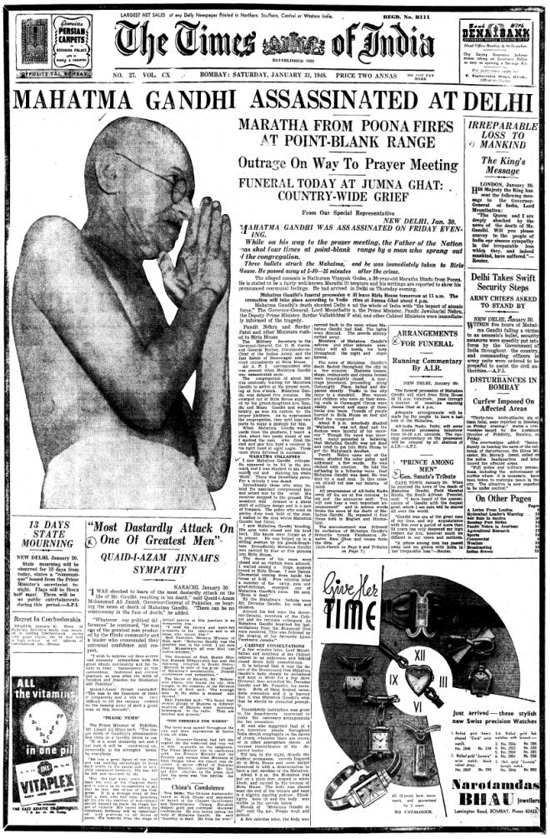 |
| The Times of India, first header: "The Bombay Times and Journal of Commerce" (Saturday, November 3, 1838) |
Names:
--- "The Bombay Times and Journal of Commerce" (November 3, 1838)
--- "Bombay Times and Standard" (1860-1861)
--- "The Times of India" (since September 28, 1861)
--- "The Bombay Times and Journal of Commerce" (November 3, 1838)
--- "Bombay Times and Standard" (1860-1861)
--- "The Times of India" (since September 28, 1861)
Category: Newspapers
Founder: Raobahadur Narayan Dinanath Velkar
First issue: November 3, 1838 - Mumbai (then Bombay), Maharashtra, India
First editor: J.E. Brennan
First format: Broadsheet
First price: 1 year = 30 Rupees
Overview: Originally called "The Bombay Times and Journal of Commerce", the paper was founded in 1838 in Mumbai (then Bombay), during the British Raj, to serve the British residents of western India, following Lord Metcalfe's Act of 1835 which removed restrictions on the liberty of the Indian press. Its first editor J.E. Brennan, a retired Irish doctor, was also secretary of the Bombay Chamber of Commerce. In the first issue, he wrote on the need of education for the people of India "whose capacity for improvement is inferior to that of no one elsewhere but were victims of ignorance and delusion". At first, the paper published twice weekly, Wednesdays and Saturdays, under the direction of Raobahadur Narayan Dinanath Velkar, a Maharashtrian Reformist, and contained news from Britain and the world. In 1840, the newspaper changes hands and George Buist becomes the editor. The paper became a daily in 1850.
In 1859, new editor Robert Knight merged "The Bombay Times and Journal of Commerce" with two more popular newspapers – "Bombay Standard" and "Chronicle of Western India", and founded "Bombay Times and Standard".
Two years later, on Sept. 28, 1861, Knight merged "Bombay Times and Standard" with "Bombay Telegraph & Courier", and renamed "The Bombay Times and Standard" to "The Times of India".
Knight fought for a press free of prior restraint or intimidation, frequently resisting the attempts by governments, business interests, and cultural spokesmen and led the paper to national prominence.
In 1880, The Times of India Weekly Edition was launched.
In 1890, the newspaper printed 3,000 copies daily.
The Times of India saw its ownership change several times until 1892, when Thomas Bennett and Frank Morris Coleman acquired the newspaper through their new company: Bennett, Coleman & Co. Ltd.
 |
| Robert Knight (1825 - 1892), the editor who reinvented the newspaper under the name "The Times of India" (1861) |
Two years later, on Sept. 28, 1861, Knight merged "Bombay Times and Standard" with "Bombay Telegraph & Courier", and renamed "The Bombay Times and Standard" to "The Times of India".
Knight fought for a press free of prior restraint or intimidation, frequently resisting the attempts by governments, business interests, and cultural spokesmen and led the paper to national prominence.
In 1880, The Times of India Weekly Edition was launched.
In 1890, the newspaper printed 3,000 copies daily.
The Times of India saw its ownership change several times until 1892, when Thomas Bennett and Frank Morris Coleman acquired the newspaper through their new company: Bennett, Coleman & Co. Ltd.
Property: The Times Group - Bennett Coleman & Co. Ltd
Official website: https://timesofindia.indiatimes.com
Official website: https://timesofindia.indiatimes.com
 |
| The Times of India, front page of the first issue (November 3, 1838). The front page is taken up solely by classified advertisements, a practice that continues up to 1939. |
 |
 |
 |
| The Times of India, employees at Mumbai during the newspaper's Diamond Jubilee (60th Anniversary, November 1898) |
 |
| The Times of India, when India lost the father of the nation (January 31, 1948) |
 |
 |
| The Times of India, commemorative stamp featuring "Common Man" - a character by cartoonist R.K. Laxman, issued by Indian Post to mark 175 years (November 13, 2013) |
 |
| The Times of India in its advanced version (June 25, 2016 - Brexit) |



